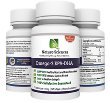A tricky thing about determining how many eggs a woman has left is combining the findings from your blood work with medical history and physical examination to arrive at a complete picture.
Although a simple measure of FSH on cycle day 3 in either a home test or at the doctor’s office will give you a rough estimate of what’s going on, taking a smarter approach on such an important matter is of course much better.
What do I mean by that?
In addition to FSH (which should be tested over several consecutive cycles and not only once!), you need to take an AMH test (simple, cheap blood test that can be done on any day of the cycle).
Put together in a right way, these two hormones will give a solid estimate of your fertility status.
However, if you want an even more detailed picture (if you would like to talk to me, here is how you can contact me), then there are still two more parameters that you should not miss.
The good news is, both are very easy to determine and it’s a shame, in my opinion, that girls are not taught in primary school already about how important they are.
The first one is the antral follicle count (here I wrote a separate article about what it is).
The second is the age of your mom’s menopause, which I want to address in more detail today.
Mother’s menopause predicts daughter’s fertility
Scientists from Copenhagen University Hospital in Denmark have measured how fertility in daughters correlates with their mothers’ age of menopause (“Maternal menopause as a predictor of anti-Mullerian hormone level and antral follicle count in daughters during reproductive age“). A total of 527 women were divided in three groups:
- those whose mothers had an early menopause (before the age of 45),
- those whose mothers had a normal menopause (age 46 to 54), and
- those whose mothers had a late menopause (55 and above).
The results showed that in women whose mothers had an early menopause, egg supply tended to decline faster and this difference was significant.
Median AFC declined by 5.8% per year in the group with early maternal menopausal age (≤ 45 years), by 4.7% per year in the group with normal maternal menopausal age (46-54 years) and by 3.2% per year in the group with late maternal age (≥ 55 years) at menopause.”
This is so important that I will say it again: if your mom entered menopause very early, such as in her early forties like mine did, then it could mean that your own eggs are disappearing twice as fast as in women whose mothers went into menopause late.
Why is that so?
And how strong is this genetic link?
No one knows yet.
The mean thing is, women do not experience any symptoms of their ovaries being almost empty and depleted of eggs (the name for that is “accelerated ovarian follicular depletion”), except for a possible shortening of their cycle length and the occurrence of subfertility.
Don’t be like me.
Don’t find out that your mom went into menopause at 42 when you are over 35 yourself and struggling to get pregnant. Talk to your mom earlier.
One more thing: The relation between the start of menopause in mothers and their daughters’ fertility was not the only interesting result of the study. One detail that shocked me was that that number of eggs was about 11% lower in women whose mothers smoked while they were pregnant!
Is that not amazing how a single lifestyle parameter in apregnant woman can affect her offspring long-term?
So ask your mom everything that comes to your mind: How was her diet while she was pregnant with you? Was she exposed to any extreme life circumstances or severe stress? Was she exposed to radiation? Did she smoke? All this could affect your ovarian reserve and your egg quality.
P.S. If you need to discuss anything related to your fertility journey or have any specific questions related to improving egg quality, you can find me here. See you next week!
Supplements which are scientifically proven to increase egg quality:
To know when you ovulate:
Prenatal vitamins:















